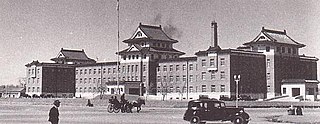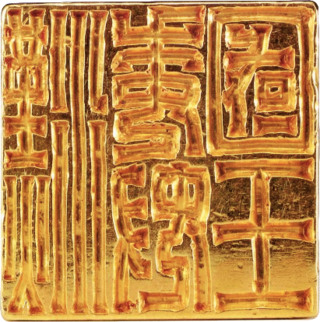| World War II |
|---|
| Navigation |
| Timelines of World War II |
|---|
| Chronological |
| Prelude |
| By topic |
| By theatre |
This article is concerned with the events that preceded World War II in Asia.
| World War II |
|---|
| Navigation |
| Timelines of World War II |
|---|
| Chronological |
| Prelude |
| By topic |
| By theatre |
This article is concerned with the events that preceded World War II in Asia.
This section may contain material not related to the topic of the article .(February 2011) |
The revolution led by the Kuomintang (KMT, or Chinese Nationalist Party) and others ended the last Chinese dynasty, the Qing dynasty, which was replaced by a republic, the Republic of China, in 1912. Prior to World War I, however, the ROC central government failed to effectively rule its territory. China fell into a fragmented region of local warlords. Other than the warlord-controlled central government, two primary forces aimed to unite China under their ideology. The KMT was reorganized in 1919, and the Chinese Communist Party was formed in 1921. The two parties were not immediate enemies and had short-term partnership. In 1924, KMT started a military campaign to defeat the northern warlords. In 1927, with much of southern and central China under the KMT control, the KMT openly turned on the CPC. The KMT took most parts of China under its power in 1928, and the warlord controlling Manchuria agreed to KMT leadership of Generalissimo Chiang Kai-shek.
The following events played a significant role in setting the stage for the involvement of Asia and the Pacific in World War II:
Many historians argue that World War II began with the Marco Polo Bridge Incident on July 7, 1937. While other historians believe the war began with the Mukden Incident in Manchuria on September 18, 1931. Japanese occupation of much of Asia would last until 1945.


The Chinese Civil War was fought between the Kuomintang-led government of the Republic of China and the forces of the Chinese Communist Party (CCP), with armed conflict continuing intermittently from 1 August 1927 until 7 December 1949, resulting in a CCP victory and control of mainland China in the Chinese Communist Revolution.
Sino-Japanese War most often refers to:

The Second Sino-Japanese War was the war fought between the Republic of China and the Empire of Japan from 1937 to 1945 as part of World War II. It is often regarded as the beginning of World War II in Asia. It was the largest Asian war in the 20th century and has been described as "the Asian Holocaust", in reference to the scale of Japanese war crimes against Chinese civilians. It is known in Japan as the Second China–Japan War, and in China as the Chinese War of Resistance against Japanese Aggression.

The Northern Expedition was a military campaign launched by the National Revolutionary Army (NRA) of the Kuomintang (KMT) against the Beiyang government and other regional warlords in 1926. The purpose of the campaign was to reunify China, which had become fragmented in the aftermath of the Revolution of 1911. The expedition was led by Generalissimo Chiang Kai-shek, and was divided into two phases. The first phase ended in a 1927 political split between two factions of the KMT: the right-leaning Nanjing faction, led by Chiang, and the left-leaning faction in Wuhan, led by Wang Jingwei. The split was partially motivated by Chiang's Shanghai Massacre of Communists within the KMT, which marked the end of the First United Front. In an effort to mend this schism, Chiang Kai-shek stepped down as the commander of the NRA in August 1927, and went into exile in Japan.
The history of the Republic of China began in 1912 with the end of the Qing dynasty, when the Xinhai Revolution and the formation of the Republic of China put an end to 2,000 years of imperial rule. The Republic experienced many trials and tribulations after its founding which included being dominated by elements as disparate as warlord generals and foreign powers.

The Mukden incident was a false flag event staged by Japanese military personnel as a pretext for the 1931 Japanese invasion of Manchuria.

This timeline of events preceding World War II covers the events that affected or led to World War II.

The Tanggu Truce, sometimes called the Tangku Truce, was a ceasefire unequal treaty that was signed between the Republic of China and the Empire of Japan in Tanggu, Tianjin, on May 31, 1933. It formally ended the Japanese invasion of Manchuria, which had begun in 1931.
The German Empire established diplomatic relations with the Republic of China in October 1913. After World War I and the creation of the Weimar Republic, Germany followed a policy of friendship towards China. Nazi Germany and the Nationalist government of the Republic of China maintained bilateral relations between 1933 and 1941. The Chinese Nationalists sought German military and economic support to help them consolidate control over factional warlords and resist Japanese imperialism. Germany sought raw materials such as tungsten and antimony from China. During the mid-1930s, thousands of Chinese soldiers were trained by German officers and German economic investment made its way into China. However, Joachim von Ribbentrop strongly favored an alliance with Japan over one with China, and starting with the 1936 Anti-Comintern Pact, Germany began to realign its East Asia policy. After Japan invaded China in 1937 and Ribbentrop became Foreign Minister the following year, German aid to China was cut off. In July 1941, Nazi Germany severed relations with Nationalist China and transferred their recognition to the Japanese-controlled Wang Jingwei regime. Nonetheless, China did not officially declare war on the Axis Powers until after the attack on Pearl Harbor.

The Warlord Era was a period in the history of the Republic of China when control of the country was divided among former military cliques of the Beiyang Army and other regional factions from 1916 to 1928.

Foreign concessions in China were a group of concessions that existed during the late Imperial China and the Republic of China, which were governed and occupied by foreign powers, and are frequently associated with colonialism and imperialism.

Zhang Jinghui ; was a Chinese general, warlord and politician during the Warlord era. He is noted for his role in the Japanese puppet regime of Manchukuo in which he served as Prime Minister for most of its existence.

Sino-Soviet relations, or China–Soviet Union relations, refers to the diplomatic relationship between China and the various forms of Soviet Power which emerged from the Russian Revolution of 1917 to 1991, when the Soviet Union ceased to exist.

After the fall of the Qing dynasty in 1912, China underwent a period of instability and disrupted economic activity. During the Nanjing decade (1927–1937), China advanced in a number of industrial sectors, in particular those related to the military, in an effort to catch up with the west and prepare for war with Japan. The Second Sino-Japanese War (1937–1945) and the following Chinese civil war caused the retreat of the Republic of China and formation of the People's Republic of China.

The Marco Polo Bridge incident, also known as the Lugou Bridge incident or the July 7 incident, was a battle during July 1937 in the district of Beijing between China's National Revolutionary Army and the Imperial Japanese Army.

The "century of humiliation" is a term used among the Sinosphere to describe the period in Chinese history beginning with the First Opium War (1839–1842), and ending in 1945 with China emerging out of the Second World War as one of the Big Four and established as a permanent member of the United Nations Security Council, or alternately, ending in 1949 with the founding of the People's Republic of China. The century-long period is typified by the decline, defeat and political fragmentation of the Qing dynasty and the subsequent Republic of China, which led to demoralizing foreign intervention, annexation and subjugation of China by Western powers, Russia, and Japan.

The Republic of China (ROC), or simply China, was a sovereign state based on mainland China from 1912 to 1949 prior to the government's relocation to Taiwan, where it continues to be based today. The ROC was established on 1 January 1912 during the Xinhai Revolution against the Qing dynasty, ending the imperial history of China. The Republican government was ruled by the Kuomintang (KMT) as a one-party state based in Nanjing from 1927, until its flight to Taipei on 7 December 1949 following the KMT's de facto defeat by the Chinese Communist Party (CCP) in the Chinese Civil War. The CCP proclaimed the People's Republic of China on 1 October 1949, while the ROC retains control over the "Free Area", with the political status of Taiwan remaining in dispute to this day.

The Kwantung Army was a general army of the Imperial Japanese Army from 1919 to 1945.

The history of China–Japan relations spans thousands of years through trade, cultural exchanges, friendships, and conflicts. Japan has deep historical and cultural ties with China; cultural contacts throughout its history have strongly influenced the nation – including its writing system architecture, cuisine, culture, literature, religion, philosophy, and law.

Lieutenant General Sasaki Tōichi was a Japanese soldier who served in the Imperial Japanese Army. He was known as an expert on Chinese affairs, had close relationships with leading figures in the Kuomintang (KMT)'s National Revolutionary Army during the 1920s, and expressed sympathy for their cause. A violent encounter with KMT forces during the 1928 Jinan incident, however, led him to abandon his pro-KMT stance, and adopt a pessimistic attitude toward China. He later served as chief military advisor to the Japanese puppet state Manchukuo, and during the Second Sino-Japanese War, he was involved in perpetrating the Nanjing massacre. In the last days of the Second World War, Sasaki was captured by Soviet troops and handed over to the Chinese communists, who interned him at the Fushun War Criminals Management Centre, where he died in 1955. He was a prolific writer, and left detailed accounts of his experiences in China.